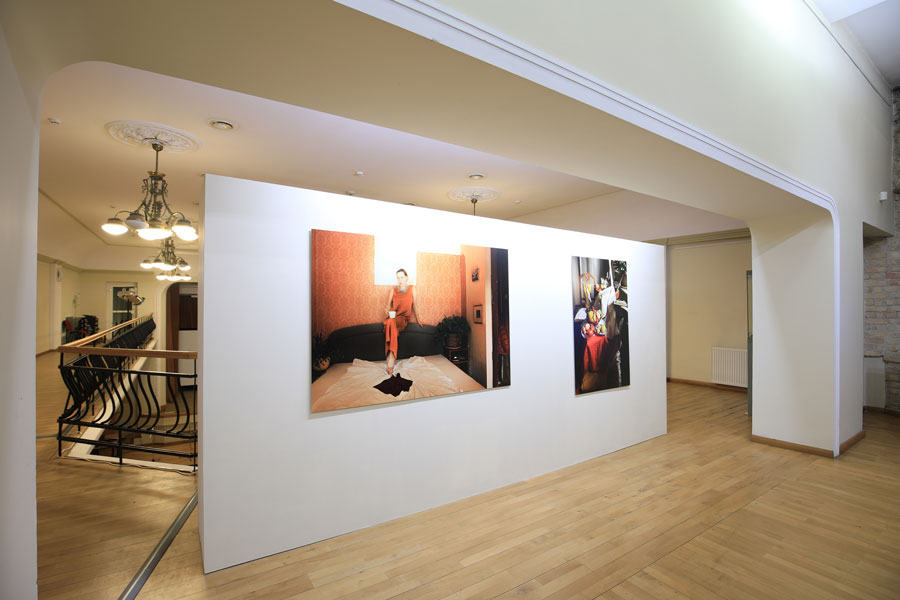Egle the Queen of Serpents
(2019 - 2021)
The title of the series is doubly significant because the photographs feature the highly respected Lithuanian actress Egle Mikoliunite – a forceful, larger-than-life personality possessing keen political awareness and national affinity – who has played dramatic, emotional, and provocative roles in both the theater and the cinema.
Angelika Sher, whose work centers on richly detailed staged photography, recounts her version of the myth through photographs full of allusions, symbols, and cultural associations referring to the history of art and literature.
Angelika Sher, whose work centers on richly detailed staged photography, recounts her version of the myth through photographs full of allusions, symbols, and cultural associations referring to the history of art and literature.








Exhibition @ Jewish Museum, Vilnius



Egle the Queen of Serpents
Longing for what is bygone has led Angelika Sher - a Lithuania-born artist who now lives in Israel – to return to her birth place and create a photographic series based on a local folk tale. The title of the series is doubly significant because the photographs feature the highly respected Lithuanian actress Egle Mikoliunite – a forceful, larger-than-life personality possessing keen political awareness and national affinity – who has played dramatic, emotional, and provocative roles in both the theater and the cinema.
Angelika Sher, whose work centers on richly detailed staged photography, recounts her version of the myth through photographs full of allusions, symbols, and cultural associations referring to the history of art and literature.
The Soviet-style public housing blocks, with their harsh, gray exteriors, and their interiors teeming with busy lives constrained within green and Baroque blue walls, were the setting of Sher's childhood. She has come back to photograph Mikoliunite's housing project apartment, going back in time to the rooms and kitchen of her mother's home, where reality and imagination, folk tales and familial memories all mingled together.
The apartment is like a time capsule – a small, claustrophobic space, crowded with many objects, creating a sense of suffocation but also of warmth and safety. Within the isolated box, there exists a surreal reality unbound by rules and norms and is independent of outside events.
The series of photographs, like the folk tale, opens with the night dress – a symbol of innocence and simplicity, and of the violation that would follow.
In the legend of Egle, beauty reveals itself and true love is possible in a secret, intimate, faraway place: the water snake becomes a desirable man, and Egle finds happiness and joy. Similarly, inside the housing project apartment, which is a hiding place or a cocoon, a rich inner world exists, detached from the outside, preserving its selfness and independence. Egle sits on the double bed in her full glory and beauty, a single blanket at her feet. A diamond shape is sewn into its center, like in a playing card, the karma of glamorous aloneness.
Angelika Sher's series addresses the arts of photography and the stage, as well as the price a woman who chooses to devote her life to art must pay. In her key novel, A Room of One's Own, Virginia Woolf defined the necessary conditions for a woman artist – financial independence and a private space. In the old, broken-down, dismal kitchen, Egle stands dressed in a gorgeous ancient kimono – a museum-quality object whose worth is beyond estimate – which Mikoliunite has received as a sign of appreciation for a dramatic role she had played.
There is something almost spiritual in the detachment from materiality and the austerity of the apartment, which has maintained its Soviet character as if outside events have no significance. The fortitudes and the creativity emanate from inner, private places, where the human essence is revealed, and from where its creative energy flows.
The tragic story of Egle ends with her sons turning into trees - oak, European ash, and birch – and Egle herself becomes a fir tree. The myth contains two metamorphoses, or shape-shifting (from water snake to man, from man to tree). In folk tales, shape-shifting is a product of magic or a super-power. Choosing acting as a way of life is a kind of shape-shifting, as is the election of a life of making art – an expression of the longing for eternal life.
The current focus on the near past is typical of both Lithuania and all of Europe, raising inherent conflicts when textual or visual interpretation changes the narrative. This tension also exists in the gap between personal and collective memory. The two viewpoints, looking outward at the housing project and inward at the hidden and private interior, and the exposure of the secrets of recent history, create an inevitable, emotionally charged conflict.
In the last photograph in the series, like laundry spread outside in the sun (a metaphor for the revealed secret), features a shawl suggesting Veronica's Veil, which is actually the original act of photography – an imprint, like a negative, of Jesus's face. The shawl is embroidered with Yin and Yang symbols, two opposing but complementary forces that exist within all things in the universe, always in motion, never in a stationary, finite state.
The story of mythical Egle also holds a warning about the inherent danger of returning – an act whose repercussions can be disastrous. Mythical Egle pines her childhood home and does everything in her power to go back there. The consequences of her visit are tragic; her happiness is exposed, her brothers murder her husband, and her life is in ruins. In reality, the Vilnius apartment where the series was shot had been demolished during a renovation and revitalization of the whole area, and there is no way now to experience the travel back in time. The shawl in the photograph represents Time and life's changes. It might be the white flag of surrender and acceptance, but also a wave of goodbye.